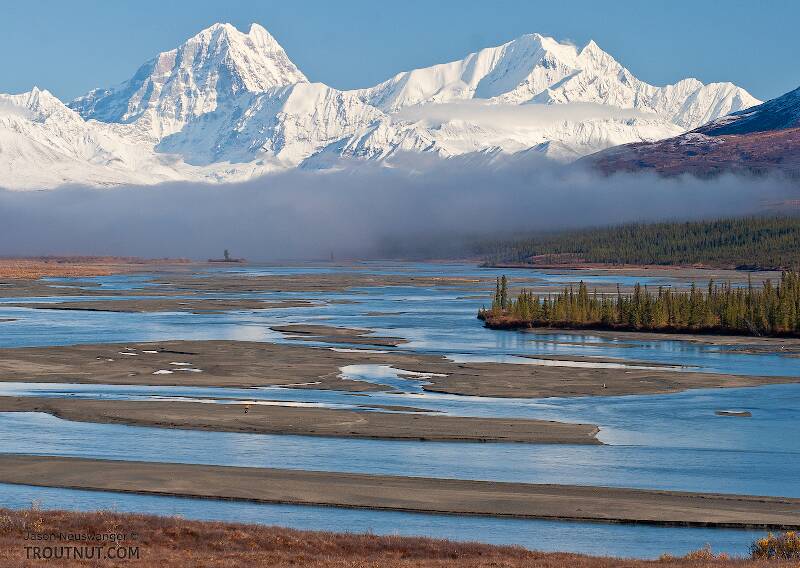
Hex Mayflies
Hexagenia limbata
The famous nocturnal Hex hatch of the Midwest (and a few other lucky locations) stirs to the surface mythically large brown trout that only touch streamers for the rest of the year.
Featured on the forum

This one was surprisingly straightforward to identify. The lack of a sclerite at the base of the lateral hump narrows the field quite a bit, and the other options followed fairly obvious characteristics to Clostoeca, which only has one species, Clostoeca disjuncta.

Troutnut is a project started in 2003 by salmonid ecologist Jason "Troutnut" Neuswanger to help anglers and
fly tyers unabashedly embrace the entomological side of the sport. Learn more about Troutnut or
support the project for an enhanced experience here.
Ike on Sep 29, 2013September 29th, 2013, 7:03 pm EDT
what is the best way to potentially deal with a stream that steadily warming due to close by housing development? obviously removing the development would do it but if thats not possible what can be done? restructuring the bank? plant trees around the banks? maybe even a bottom release damn? just wondering how other streams have tackled the issue.
Stokes on Oct 1, 2013October 1st, 2013, 7:50 am EDT
Just curious,how did the development cause the warming?
Troutnut on Oct 1, 2013October 1st, 2013, 5:37 pm EDT
Yeah, we need more details before anyone can answer this question.
Development can cause streams to warm in various ways. For example, pavement usually leads to warm quick runoff and lower water levels between rain, while the natural soil might soak up the rain and release it over a longer period of time as cool ground water. Cutting riparian vegetation so sunlight hits a stream can have a major warming effect, too. In worst case scenarios, development could impede the flow of a natural cold spring so the water warms up before it hits the stream. All of this depends on the size of the developed area relative to the size of the stream. It would be unusual for a single housing development to substantially warm a decent-sized stream, but it's probably not totally out of the question.
Development can cause streams to warm in various ways. For example, pavement usually leads to warm quick runoff and lower water levels between rain, while the natural soil might soak up the rain and release it over a longer period of time as cool ground water. Cutting riparian vegetation so sunlight hits a stream can have a major warming effect, too. In worst case scenarios, development could impede the flow of a natural cold spring so the water warms up before it hits the stream. All of this depends on the size of the developed area relative to the size of the stream. It would be unusual for a single housing development to substantially warm a decent-sized stream, but it's probably not totally out of the question.
Jason Neuswanger, Ph.D.
Troutnut and salmonid ecologist
Troutnut and salmonid ecologist
Entoman on Oct 3, 2013October 3rd, 2013, 12:54 pm EDT
Headwater and tributary drainage degradation (usually meaning deforestation) and upstream top spilling dams are other causes.
Is the water only warming below the development? If so, is there a major trib or groundwater source entering at or near the development that could have its own issues? Was adjacent riparian habitat destroyed by the development - is drainage from it entering the stream? Regulations are pretty strict now on the impact of storm drainage and the management of waste water for projects in close proximity to watersheds. How old is it?
Is the water only warming below the development? If so, is there a major trib or groundwater source entering at or near the development that could have its own issues? Was adjacent riparian habitat destroyed by the development - is drainage from it entering the stream? Regulations are pretty strict now on the impact of storm drainage and the management of waste water for projects in close proximity to watersheds. How old is it?
"It's not that I find fishing so important, it's just that I find all other endeavors of Man equally unimportant... And not nearly as much fun!" Robert Traver, Anatomy of a Fisherman
Quick Reply
Related Discussions
Topic
Replies
Last Reply
Re: Which aquatic insects are most vulnerable to pollution???
In the Identify This! Board by Byhaugh
In the Identify This! Board by Byhaugh
4
Aug 14, 2014
by Lastchance
by Lastchance
1
Sep 14, 2010
by SlateDrake9
by SlateDrake9
Re: Upper Peninsula Chinook (King) Salmon Highlights 2012 Video HD
In the Photography Board by Pryal74
In the Photography Board by Pryal74
6
Oct 18, 2012
by Orn
by Orn



